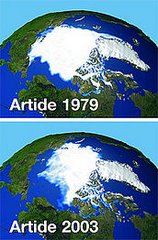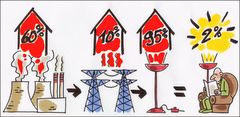'The clever way: better with less' Heating and cooling.
It should, however, be noted that in moderate and cold climate zones, space heating takes up at least half of the overall energy use. Therefore, proper insulation and ventilation is the first and most important energy saving measure. It can reduce heating needs to one-third (about 50 kWh heat/m2/y) or even one tenth (less than 15 kWh heat/m2/y) of what an average house would need.
Remarkably, a properly insulated house, which only needs a third of the heat to keep you warm, will not be more expensive to build. The extra investments in insulation, ventilation and high-efficiency glazing, can be offset by a smaller and cheaper heating system.
An efficient house will also be healthier and more comfortable to live in - it avoids 'cold radiation' (as from windows), the differences of temperature between heated and non-heated rooms is less, and it can be more efficiently ventilated.In hot regions, energy use for active cooling (air conditioning) can be minimised or even avoided if the construction is well-thought out. In a moderated climate, active cooling can always be avoided.
Electricity consumption in households differs immensely throughout the world. Even within the OECD (industrialised countries), an average European household consumes 4,667 kWh, whereas a household in the US consumes 11,209 kWh and in Japan 5,945kWh per year.
A US household uses three times more electricity for lighting, and twice as much in refrigerators than in the EU. This does not necessarily reflect a difference in comfort. As we will explain, there are high efficiency appliances that consume two to 10 times less electricity for an equal functionality, and that are most often also of higher quality.
Using only highly efficient and money saving appliances can reduce the electricity consumption of an average household to as low as 1,300 kWh/y, without any loss of comfort. This is almost 10 times less than the US average.
 Try to minimise electricity use: its generation needs a lot of energy, mostly heat produced in coal, gas or nuclear plants.
Try to minimise electricity use: its generation needs a lot of energy, mostly heat produced in coal, gas or nuclear plants.Using electric hot water heaters or space heating is extremely inefficient. At the power plant, some 60 percent of the energy is lost as waste heat.
Another 10 percent is lost in electricity lines and transformers before the electricity even reaches your home.

1. Use efficient lighting
Replace incandescent bulbs with compact fluorescents (CFLs). Compact fluorescents use four times less energy, and last eight times longer (8,000h instead of 1,000h) than incandescent light bulbs.
For example, a typical 75W incandescent bulb will be replaced by an 18W compact fluorescent.
The compact fluorescent will be more expensive to buy, but you will need to replace it eight times less often and it will use less electricity, which often makes it the biggest electricity saver in your house. At a minimum, we recommend replacing the bulbs in all lamps that are used for 30min/day or more.Fluorescent tubes are even more efficient than compact fluorescent lamps, and last even longer (10,000-20,000h). Only use tubes with a modern ballast starter that avoids flickering and lights immediately - good ones add another 20 percent efficiency.
Another option is a CFL with a dedicated fixture. The electronic ballast which is part of the fixture lasts 40,000 hours and bulbs can be replaced separately at lower cost. Both CFLs and fluorescent tubes are available in a dimmable fixtures. This can increase comfort, save even more energy and extend the lifetime of the bulb.Especially avoid halogen floor lamps, which typically have a power of 300W or more, produce lots of heat and are actually so hot (some 500° Celsius) that they can cause serious burns and start fires. Besides, on hot summer days they are very uncomfortable to be around. A CFL floor lamp only uses 50-80W at 40° Celsius.
They can save loads of energy and even your life.Also pay attention to the light fixtures. Clever use of reflectors, and directional lamps to get the light where you need it can save you another 50 percent energy cost and improve your comfort!
Well thought out use of efficient lights can thus reduce electricity needs up to 8 times.CFLs at the end of their operating life should be disposed of properly so the mercury inside can be recycled. To be clear, even if not recycled, CFLs are still the better choice, since the inefficiency of incandescent and halogen lights causes far greater environmental damage - including mercury emissions from coal fired power plants. (But please do recycle the CFLs.)
Also, conversion to efficient lighting often leads to an increase in the use of light. To some degree, this can be a positive effect, as it can increase comfort and your well-being. But it can also lead to wasting light, such as leaving lamps on when there is no need to (e.g. when you leave the room). This is reinforced by the misconception that turning CLFs on and off is expensive. As a general rule, always turn off the lights when you leave the room or the house.
2. Buy efficient electric appliances.
They use two to 10 times less electricity for the same functionality, and are mostly higher quality products that last longer than the less efficient ones. In short, efficient appliances save you lots of energy and money.In many countries, efficiency rating labels are mandatory on most appliances. In the EU, models are labelled A++ for the most efficient, then A+, A, B, C, D for subsequently less efficient models. Look for the A++ or A+ models. In the US, the Energy Star label is used.The label gives you information on the annual electricity consumption. In the paragraphs below, we provide some indication of the consumption of the most efficient appliances to use as a rough guide when shopping. Lists of brands and models and where to find them are country-specific and so cannot be listed here, but check the links on this page for more detailed information.Average consumption of electric appliances in different regions in the world, compared with the high efficient models on the market.
3. Refrigerators
Buy a high efficiency refrigerator that consumes around 100 kWh/y. This is 10 times less than the average in the US, and four times less than the EU average. Remarkably, energy consumption by the most efficient refrigerator models is largely unrelated to their size. The most efficient 400-litre fridge on the market today only consumes 106kWh/y. These efficient refrigerators are about 5-15 percent more expensive to buy, but will save you loads of money and energy in use. In general, they are also high quality products that will last longer, will need less repairing and make less noise.Avoid refrigerators with a built-in frozen food compartment, if you have a separate freezer. These models are less efficient and you loose cooling space.
4. Freezers
For most home consumers it is better to buy a two door refrigerator/freezer combination with separate compartments, than a separate refrigerator and freezer. Refrigerator/freezer combinations where the freezer is at the top or bottom of the unit are generally better than ones with side by side doors. Of course, you should always compare energy consumption ratings, pay attention to energy efficiency labels and look for Greenfreeze technology.
This award-winning two door refrigerator/freezer only consumes 137kWh/year.Chest type models are more efficient than uprights.Unlike refrigerators, with freezers size does matter. Larger freezers do need more electricity. So don't buy a freezer that is larger than you need, especially if you live close to the store. The most efficient models on the market will only use 180 kWh for a 300 litre chest, and 240 kWh/y for a large 450 litre freezer chest. The best upright models range from 170 kWh for a 190 litre model to 220 kWh for a 310 litre model.
5. Clothes washing machines
Buy a high-efficiency model with a power consumption of less than 0.9 kWh/washing cycle. Consider a 'hot fill' model which connects directly to your efficient gas-fired water heater. Using gas to heat the water almost halves electricity consumption.
Installing a hot fill appliance needs to be done correctly, so good advice is required.Check the energy label.
The EU A+/A/A label will guarantee you the best energy efficiency and washing and drying result.If using a clothes dryer, make sure that your washing machine can spin at 1600 or even 1800 rpm.The most efficient washing machines save some 1,500 litres of water per year - a double gain!
6. Clothes dryers
Traditional clothes dryers are very energy intensive. So-called 'condensation' models – without an exhaust tube – use even more energy. Consider drying the natural way (i.e. on a clothes line outdoors) if practical, this will save you 3-4 kWh/washing cycle.If line drying is not an option, first make sure that your washing machine can spin at 1600 or even 1800 rpm. This will almost halve the energy needed for drying.
Drying through spinning is 20 times less energy intensive than with heat.
There are two clothes-drying technologies that use far less energy: the gas-fired clothes dryer and the dryer with an electric heat pump. The gas-fired dryer is the best alternative, especially for more intensive use: it uses 60 percent less energy (including the gas) and dries 40 percent faster. If gas is not available, consider a dryer with a heat pump.
A heat pump dryer will use half the electricity of a traditional dryer.
However, heat pumps can be rather expensive. And in summer, just let the clothes get dry under the sun....!!!!!!
7. Dishwashers
An efficient dishwasher consumes no more than one kWh/washing cycle, compared with 1.4 kWh for an average model.Consider a 'hot fill' model which connects directly to your efficient gas fired hot water heater.
That way, gas is used to heat the water instead of electricity, thereby reducing electricity consumption by 50 percent, or even up to 90 percent for the top models. This is because gas is almost twice as efficient for heating water as electricity. Note that installing a 'hot fill' needs to be done properly so good advice is required.
8. Computers and IT
Buy a laptop instead of a desktop, if practical. It consumes five times less electricity.
If you buy a desktop, get an LCD screen instead of an outdated CRT. Enable the power management function on your computer, the screensaver does not save energy.Check if your computer supports the more advanced Speedstep™ power management.
Switching off a computer extends its lifetime, contrary to some misconceptions. Leaving a computer running the whole year will cost you more than 1,000 kWh/y, or almost as much a the total electricity consumption of a high-efficiency household. Use one large power strip for your computer, broadband modem, scanner, printer, monitor, and speakers. Switch it off when equipment is not in use. This is a practical way to cut 200 kWh/y or more of standby losses (see standby). Minimise printing. Laser printers use more electricity than inkjet printers.
9. Cut off standby losses ("The vicious energy-suckers")
Most modern electric appliances consume electricity even when turned off. For TVs, VCRs, faxes, HiFis, computer screens, cable boxes, and broadband modems this is on average some 40 – 120 kWh/y. In total, household losses can reach several hundreds kWhs/y, all for doing nothing useful.
The best solution is to buy appliances that have a very low standby energy consumption. Standby power consumption is mentioned in the product manual and can be checked before buying.
For most appliances, it should be around 0.5 – 1 watts/hour or 4-8 kWh/year. Keep in mind that the cost of wasted standby energy over a model's lifetime can be higher than the cost of buying it!
A power strip is also the most practical way to switch of VCR, TV and DVD-player stand-by losses (you can cut off all three devices at once).
The multi socket power strip: a practical way to combat stand-by losses. This model costs only 1.8 euro and can save you more than 100kWh/y!In the 15 countries of the EU in 2000, the total energy lost to standby in households was estimated at 94 billion kWh, or the equivalent of 12 large nuclear or coal power plants. The fast growth of inefficient ICT and multimedia applications could nearly double this in 10 years.
10. Do not use an electric boiler (hot water heater) for hot water ("Heat the water, not the sky!")
An electric boiler consumes about 3,200 kWh/y (average OECD).
But producing that electricity in highly inefficient gas, coal or nuclear plants, and then transmitting that electricity down the power line to your home costs some 9,600 kWh in electricity wasted as heat - so roughly 2/3rds of the energy is lost before it even reaches your home.
Using gas or oil directly to heat water reduces energy use to 3,800 kWh.
A solar boiler can further halve that figure to 1,900 kWh in a moderate climate zone (and even less in sunny regions) - for a total energy savings of about five times what the electric boiler uses.
However, do not use a solar boiler combined with an electric heating, as this will be less efficient than a gas boiler alone - the energy cost of the electric heating usually wipes out the savings gained by the solar boiler.
11. Use a water-saving shower head
The water-saving shower head delivers high comfort for only half of the water use (5-7 litres/min. Instead of 10-18 litres/min.). Hot water is the second most important area of energy use in a household, after space heating, and thus needs extra attention. An efficient shower head can save almost 1,500 kWh electricity/y if an electric boiler is used, or 1,900 kWh heat if a gas or oil boiler/geyser is used.
All this for just a few dollars/euros extra when you buy the showerhead.
Over its lifetime of 10 years, a showerhead will also save some 70,000 litres of water.Using a water-saving showerhead, combined with a solar boiler reduces energy needs to some 950 kWh heat (gas or oil), or almost 10 times less than when an electric boiler is used with a traditional shower head!
12. Do not use electric space heating
Same reasons as for the electric boiler. Instead add insulation, and (ideally) heat your house using a renewable energy solution like solar thermal. However, gas heating is still far better than electric heating.
(MAIN SOURCE: http://www.greenpeace.com)
USEFUL LINKS:
(additional info about)
http://www.greencampus.harvard.edu/cerp/takeaction.php
http://www.greenpeace.org/canada/en/take-action/greentips
http://www.greenpeace.org/international/press/reports/greenfreeze-from-snowball-to





2 comments:
Hello,
Great post/topic. Energy efficient devices/technologies are going to be crucial in driving down consumption. Lighting is such a big part of how the U.S. and world are using energy, so we need to keep improving those technologies. CFLs are a good answer for now, but OLEDs are another technology that may change the landscape in a few years. http://www.universaldisplay.com/white.htm
GE and Konica mentioned they should have OLED white lighting in a few years. http://www.popsci.com/popsci/whatsnew/11723001344d3110vgnvcm1000004eecbccdrcrd.html
I can be contacted at 610-642-8253 x 191 or at michael@gregoryfca.com
Mike
Hi mike, very nice to read your comment (the first on this blog, by the way!)! I agree with you and I will visit the links you kindly gave me.
Keep on reading and acting!!
hugs
nirvy
Post a Comment